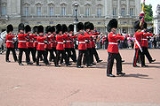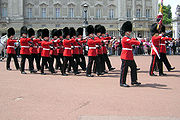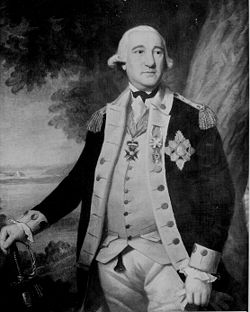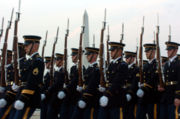
Foot Drill
Encyclopedia

Military education and training
Military education and training is a process which intends to establish and improve the capabilities of military personnel in their respective roles....
regimen of organized military
Armed forces
The armed forces of a country are its government-sponsored defense, fighting forces, and organizations. They exist to further the foreign and domestic policies of their governing body, and to defend that body and the nation it represents from external aggressors. In some countries paramilitary...
and paramilitary
Paramilitary
A paramilitary is a force whose function and organization are similar to those of a professional military, but which is not considered part of a state's formal armed forces....
elements worldwide. "Foot drill" or "Drill" stems from time since antiquity when soldiers would march into battle, be expected to gather in a formation, and react to words of command from their commanders once the battle commenced. Much of the drill done today is either ceremonial, or implemented as a core part of training in the Armed Forces. Military discipline is enhanced by drill, as it requires instant obedience to commands.
Drill proved useful when marching formations of soldiers cross-country. For example, officers could form men from an eight-wide route march formation to a two-wide formation for passing through gates and other narrow passages, without losing time or cohesion. Drill was used to efficiently maneuver formations around and through obstacles.
Drill was often used as a forerunner to great battles; during them it justified itself. It was also utilized after battles, where quick restoration of the corporate unity of an element was required.
Drill in history
VegetiusVegetius
Publius Flavius Vegetius Renatus, commonly referred to simply as Vegetius, was a writer of the Later Roman Empire. Nothing is known of his life or station beyond what he tells us in his two surviving works: Epitoma rei militaris , and the lesser-known Digesta Artis Mulomedicinae, a guide to...
composed his treatise on the Roman Empire's military, De Re Militari
De Re Militari
De Re Militari , also Epitoma Rei Militaris, is a treatise by the late Latin writer Vegetius about Roman warfare and military principles as a presentation of methods and practices in use during the height of Rome's power, and responsible for that power...
, at some point between 378 and 390 CE
Common Era
Common Era ,abbreviated as CE, is an alternative designation for the calendar era originally introduced by Dionysius Exiguus in the 6th century, traditionally identified with Anno Domini .Dates before the year 1 CE are indicated by the usage of BCE, short for Before the Common Era Common Era...
during the reign of Valentinian II
Valentinian II
Flavius Valentinianus , commonly known as Valentinian II, was Roman Emperor from 375 to 392.-Early Life and Accession :...
in the Western Roman Empire
Western Roman Empire
The Western Roman Empire was the western half of the Roman Empire after its division by Diocletian in 285; the other half of the Roman Empire was the Eastern Roman Empire, commonly referred to today as the Byzantine Empire....
. This work consists of three separate, yet related books, the first establishing methods of training and selecting new recruits, the second and third books a continuation of the first, describing in detail training and discipline matters as they pertained not only to the troops, but also to the leadership in times of training and battle, as well as positing an argument for reforms in the army.
Within these books can be found a detailed guide for drill of the army. Among these drills, the military step
Military step
Military step or march is a regular, ordered and synchronized walking of military formations.-History:The steady, regular marching step was a marked feature of Roman legions. Vegetius, the author of the only surviving treatise on the Roman Empire's military, De Re Militari, recognized the...
describes how initial training should consist of "constant practice of marching quick and together. Nor is anything of more consequence either on the march or in the line than that they should keep their ranks with the greatest exactness. For troops who march in an irregular and disorderly manner are always in great danger of being defeated. They should march with the common military step twenty miles in five summer-hours, and with the full step, which is quicker, twenty-four miles in the same number of hours. If they exceed this pace, they no longer march but run, and no certain rate can be assigned."
Drill and ceremony in the Order Of Malta
Within the Order of Malta Ambulance and Cadet Corps in Ireland, there is a tradition of Foot Drill through the ranks. Like armies all over the world there is a high standard of Foot Drill, and they hold competitions both in First Aid, Home Nursing and Foot drill once a year for the Cadet Corps and Ambulance corps to keep standards at a high level.Some of the cadet corps and ambulance corps learn their foot drill in Gaeilge.Origins of modern drill in the U.S. Military

Continental Army
The Continental Army was formed after the outbreak of the American Revolutionary War by the colonies that became the United States of America. Established by a resolution of the Continental Congress on June 14, 1775, it was created to coordinate the military efforts of the Thirteen Colonies in...
. The following year Baron von Steuben, by then a Major General and the Inspector General of the Continental Army, wrote the Army's first field manual, "The Regulations for the Order and Discipline of the Troops of the United States", which has come to be more commonly known as the "Blue Book". The methods of drill that von Steuben initiated remained largely unchanged between their inception and the time of the American Civil War
American Civil War
The American Civil War was a civil war fought in the United States of America. In response to the election of Abraham Lincoln as President of the United States, 11 southern slave states declared their secession from the United States and formed the Confederate States of America ; the other 25...
. One major change to come about since that time is that troops now march at a cadence of 120 steps per minute, instead of the original 76 steps per minute at the time of the American Revolution
American Revolution
The American Revolution was the political upheaval during the last half of the 18th century in which thirteen colonies in North America joined together to break free from the British Empire, combining to become the United States of America...
.
The stated aim of drill is to "enable a commander or noncommissioned officer to move his unit from one place to another in an orderly manner; to aid in disciplinary training by instilling habits of precision and response to the leader’s orders; and to provide for the development of all soldiers in the practice of commanding troops."
Between branches of the military, as well as between the military forces of various countries, the methods of drill will vary. In the United States Armed Forces
United States armed forces
The United States Armed Forces are the military forces of the United States. They consist of the Army, Navy, Marine Corps, Air Force, and Coast Guard.The United States has a strong tradition of civilian control of the military...
, the basis of drill procedures can be traced to von Steuben's "Blue Book".
U.S. Army drill procedures
The procedures for drill in the modern United States Army are set forth in Army Field Manual (FM) 3-21.5, Drill and Ceremonies . Part one of the field manual contains guidelines for the different aspects of drill;- Drill Instructions
- Commands and The Command Voice
- Individual Drill
- Individual Drill with Weapons
- Squad Drill
- Platoon Drill
- Company Drill
- Battalion and Brigade Drill
Distribution of the field manual is currently unlimited, and the manual can easily be found on the internet.
Drill commands

When issuing the command, vocal inflection is varied so that the preparatory command is given less emphasis, and the most emphasis is placed on the command of execution. There is usually a slight hesitation between each element of the command, about the duration of a finger snap. Other examples of the two-part command structure are:
- "Right Flank...MARCH"
- "Order...ARMS"
- "Left Shoulder...ARMS"
- "Stand at...EASE"
Drill movements
All drill movements are performed from the base position of Attention. In this position, the person performing the movement stands straight, arms down and slightly flexed, fingers curled in to the palm, thumbs pointed down and placed against the seam of the trouser, and the feet positioned at a forty-five degree angle with heels together. The most common command given by leaders to gather their elements into formations is the command "Fall IN", at which time the person takes their position in the formation and at the position of attention. From this position, almost any other drill command can be executed.Basic foot drill commands (British Army)
Squad, Squad SHUN - Move the soldiers to the position of attention. The chin is raised, with the neck in the back of the collar, chest forced out, arms held by the sides, and the hands forming a fist. The thumb should be forcing down on the index finger, and touching the seam of the trouser. The feet should be angled at 30 degrees, with the heels touching.Stand at, EASE - Move the soldiers from a position of attention to a 'braced up' position of rest.
Stand EASY - Put the soldiers to a position of rest from the STAND AT EASE position
External links
- E-text of English translation of De Re Militari
- Homepage of De Re Militari: The Society for Medieval Military History, an academic association that is concerned about medieval warfare
- An English translation of De Re Militari by Lieutenant John Clarke (1767)
- Army Study Guide.com Pubs and Forms
- Irish Order of Malta web pages
- Sovereign Order of Malta web pages (International)

